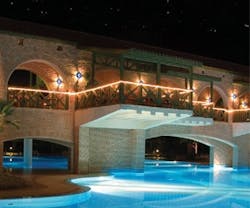Thanks to lower costs and technological advancements, solid state lighting (SSL) is gaining acceptance indoors and out.
But for all the hype surrounding new and exciting uses for LEDs, few facilities use other solid state technologies to meet their outdoor needs. Could the other SSLs benefit you?
Know Your Solid-State Lighting
The benefits and drawbacks of LED lighting are fairly well established, but that’s not the case for other semiconductor-based lighting. However, alternatives are slowly making gains as their performance and cost improve. Solid state lighting includes three types:
LEDs: The standard-bearer of SSL technology, LEDs move electrons over silicon-based compounds or other rare earth materials to create light.
OLEDs: Organic light-emitting diodes function somewhat like LEDs but use a carbon/hydrogen compound. They’re extremely thin and can be formed into flexible sheets.
Light-emitting polymers: These are made of plastic that emits light when an electric field is applied. Like OLEDs, they’re thin, lightweight, and flexible. Despite this, light-emitting polymers have not gained much traction in lighting, though they are used in screens for TVs, digital cameras, and calculators.
Explore Outdoor Options
LEDs have by far made the most gains of any SSL in outdoor applications due to their bright light and suitability for directed and diffused lighting, explains Jeff Quinlan, vice president of technology for LED lighting and controls provider Acuity Brands.
LEDs are increasingly specified for colored lighting, roadways, and applications that require optical precision, and they’re also making inroads in directional landscape lighting, explains Thor Scordelis, manager of global product marketing for LED module developer Xicato. Today’s OLEDs offer a fraction of the brightness of LEDs, making them an unlikely choice for parking lot projects, Quinlan adds.
However, OLEDs could make gains as development progresses. Their lower light output can benefit architectural applications, Quinlan adds. More development is needed before OLEDs can truly compete with other light sources in area lighting, optical precision, and other factors, but the flexible sheets are making headway.
“OLEDs can be put on curved substrates, so you could create an outdoor pillar that’s also a luminaire,” says Eric Haugaard, director of product technology for LED manufacturer Cree. “But most outdoor applications require very high optical precision to direct the illumination, uniformly, where it’s desired.”
How to Choose Outdoor SSLs
Choosing the best outdoor lighting requires a look at quality and performance indicators for the lamp and the rest of the luminaire. Examine these factors when evaluating your choices:
- Regulatory marks and certifications. Underwriters Laboratory (UL) and the Canadian Standards Association (CSA) certify products for safety, says Quinlan. CSA approval is mandatory in Canada, and some U.S. insurance policies limit liability in claims involving the failure of a device that’s not UL listed. Manufacturers also certify products to Illuminating Engineering Society (IES) standards – specifically LM79 and LM80, which cover luminaires and lumen depreciation in lamps.
- Third party recognition. The EPA’s ENERGY STAR rating system certifies efficient lighting and other products, while the DesignLights Consortium (DLC) focuses on SSLs.
- Listings. An outdoor product must be UL listed for wet locations, Quinlan says. Also look at the IP rating, which measures water resistance. A product listed as IP65 stays dry in a steady rain and an IP66-rated light can survive high-volume sprayings.
- Color. Certain situations require higher Color Rendering Index (CRI) ratings, Quinlan says. “In some applications, color quality and rendering matter more,” Quinlan adds. “If you’re in a bank, detecting false notes is important, so the CRI should be slightly higher than in an office.”
- Lifetime. Advertised lifetimes are based on how lamps perform in lab conditions, so performance in your facility may vary, advises Shelley Wald, president of WAC Lighting. “LEDs can last 100,000 hours in the lab, but based on the management of heat and amperage, we’re reliably getting 50,000 hours,” Wald says.
Don’t compromise on these points, Haugaard advises. The luminaire with the lowest first price could be more expensive in the long run if it fails early or can’t deliver optimal illumination.
“You need comprehensive performance data to significantly reduce risk,” Haugaard says. “Manufacturers that can’t provide creditable data that demonstrates their ability to meet your defined reliability, durability and performance requirements should be disqualified. Don’t compromise – it’s way too risky.”
Janelle Penny ([email protected]) is associate editor of BUILDINGS.
About the Author
Janelle Penny
Editor-in-Chief at BUILDINGS
Janelle Penny has been with BUILDINGS since 2010. She is a two-time FOLIO: Eddie award winner who aims to deliver practical, actionable content for building owners and facilities professionals.

